If it isn't obvious by now, we are fans of Thai curries. So let's make a vegetarian Thai yellow curry that is delicious, aromatic, and delivers so much flavor!

Curry is timeless. You can make it year-round, and no one will complain. Depending on the time of the year, you can choose lighter or heavier ingredients and use seasonal produce.
Making a curry vegetarian is a breeze because you only need to make sure you omit the meat, replace it with tofu and vegetables, and ensure the curry paste you use doesn't have fish sauce.
My Green Thai Curry inspired this, and pairs well with this Aromatic Jasmine Rice and Crispy Tofu, which go great with vegan stews and Chinese Tofu Recipes.
This curry made with homemade yellow curry paste recipe makes an excellent main dish for the fall season recipe, as it is creamy, cozy, and packed with flavor as all fall recipes should be!
Jump to:
💚 Why you will love it
- Simple ingredients
- Quick preparation
- Richly flavorful
- Comforting and creamy
- Nutrient-dense meal
🧾 Ingredients
The ingredients that make this curry so good are:
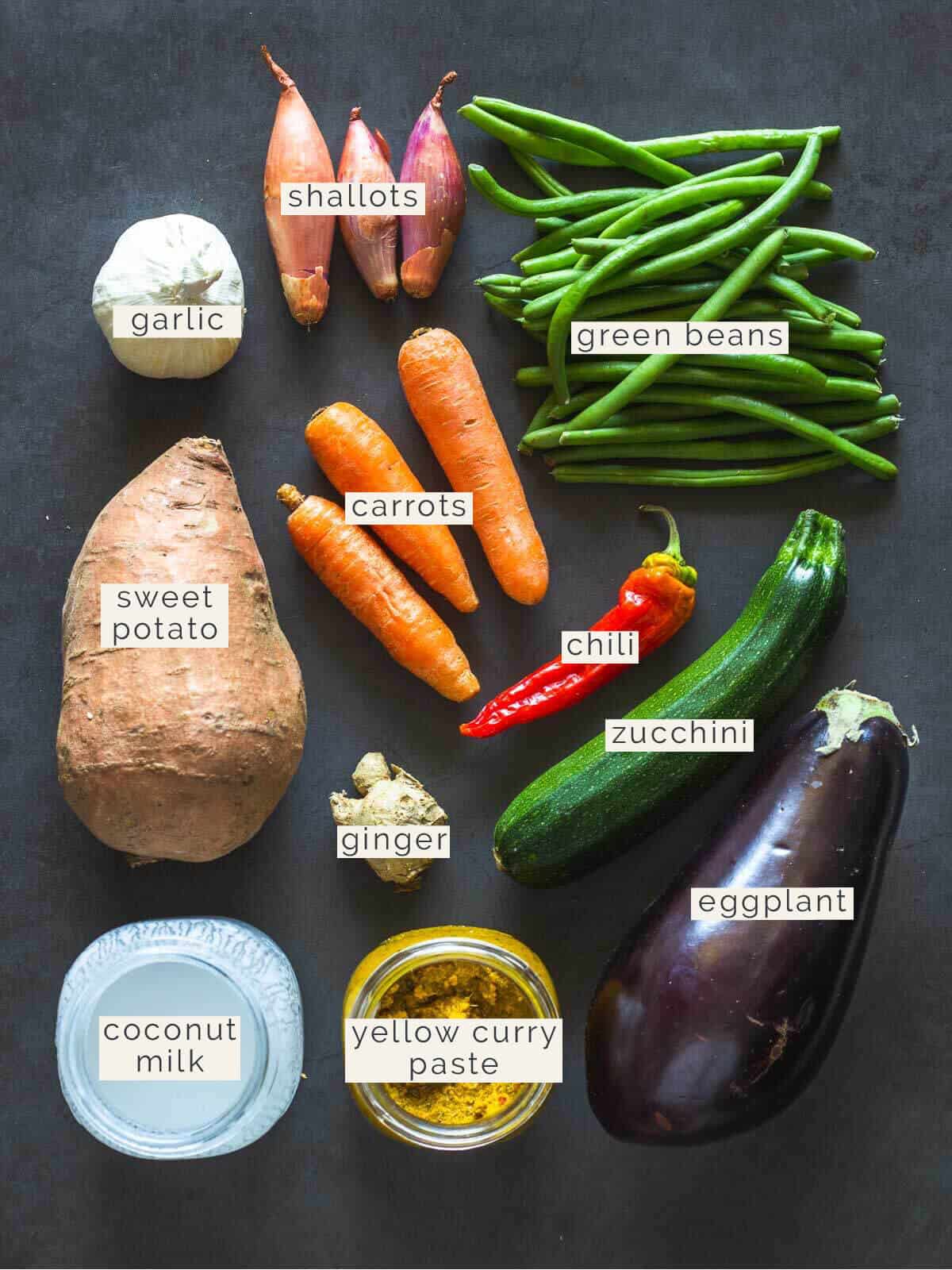
- Yellow Curry Paste: The heart of the dish, providing a burst of flavor and spice. It's a blend of herbs and spices like turmeric and lemongrass, which saves you time when preparing.
- Eggplant: This veggie is a sponge for flavors, perfect for soaking up our curry sauce. Plus, it's low in calories and fiber, which is excellent for digestion.
- Sweet Potato: Not just for its vibrant color, but sweet potatoes add a natural sweetness that balances the spiciness of the curry. They're also packed with vitamins A and C.
- Extra-firm Tofu (optional): A protein-packed addition that absorbs flavors like a champ. If you're looking to up the protein content, this is your go-to.
- Zucchini (Courgette): Adds a light, summery touch to the curry and cooks quickly. It's also a good source of vitamin C and potassium.
- Carrots: These bring a subtle sweetness and a pop of color to the dish. Carrots are also rich in beta-carotene, which is good for your eyes.
- Ginger: This root adds a zesty kick and layers of flavor complexity. Ginger is also known for its anti-inflammatory properties.
- Shallots: Milder than onions, shallots add a subtle depth to the curry. They're also rich in antioxidants.
- Garlic: A flavor powerhouse that adds a robust, earthy taste. It is also known for its immune-boosting properties.
- Full-fat Coconut Milk: For that creamy, dreamy texture we all love in a curry. If you opt for light coconut milk, it'll be less creamy but still delicious.
- Green Beans (optional): Add a crunchy texture and a pop of green. They're also a good source of fiber and vitamins.
- Red or Yellow Chili (optional): If you're looking to turn up the heat, add some chili. It's also rich in vitamin C.
Serve with Jasmine Rice.
See the recipe card for quantities.
Substitutions
| Original Ingredient | Suggested Substitution |
|---|---|
| Eggplant | Portobello mushrooms |
| Sweet Potato | Butternut squash |
| Extra-firm Tofu | Tempeh or Seitan |
| Zucchini | Yellow squash |
| Carrots | Parsnips |
| Ginger | Ground ginger |
| Shallots | Red or white onions |
| Garlic | Garlic powder |
| Coconut Milk | Vegetable stock, extra eggplant, spinach, tofu, potatoes |
| Yellow Curry Paste | Blend of yellow chilies, galangal, lemongrass, spices |
| Green Beans | Asparagus |
| Red or Yellow Chili | Bell peppers |
🍽 Equipment
I am currently cooking with my Italian stone pots, which are great multipurpose pots, but before moving, I used a great wok pan that I totally recommend.
🔪 Instructions
We need to follow some easy steps for this curry recipe.

Step 1: First, dice the vegetables, including eggplant, sweet potato, zucchini, and carrots, into medium-sized cubes.
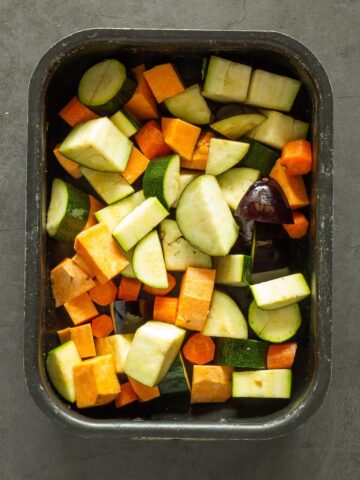
Step 2: Then, roast them in a medium pan in a preheated oven with a pinch of salt and oil.
Hint: You can simplify the process by cooking everything in one pot. If time allows, using the oven can preserve the vegetables' color and texture. For the one-pot method, add the vegetable cubes to the pot once the shallots and garlic are golden, cook for 5 minutes, then add the coconut milk and follow the usual cooking steps. Optionally, coat the vegetables with a teaspoon of coconut or avocado oil.
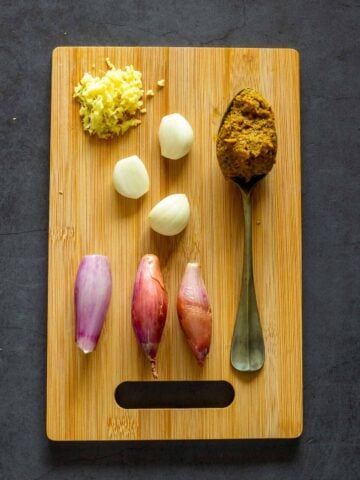
Step 3: Meanwhile, chop the shallots and garlic. Peel and shred the ginger. On medium heat, stir-fry the shallots and garlic for a minute, and add the curry paste and ginger.
Step 4: When golden, add the coconut milk and stir. Now add the oven-baked vegetables and a cup of water (or vegetable stock), and let the curry simmer. Turn off the heat and optionally top with the green beans.
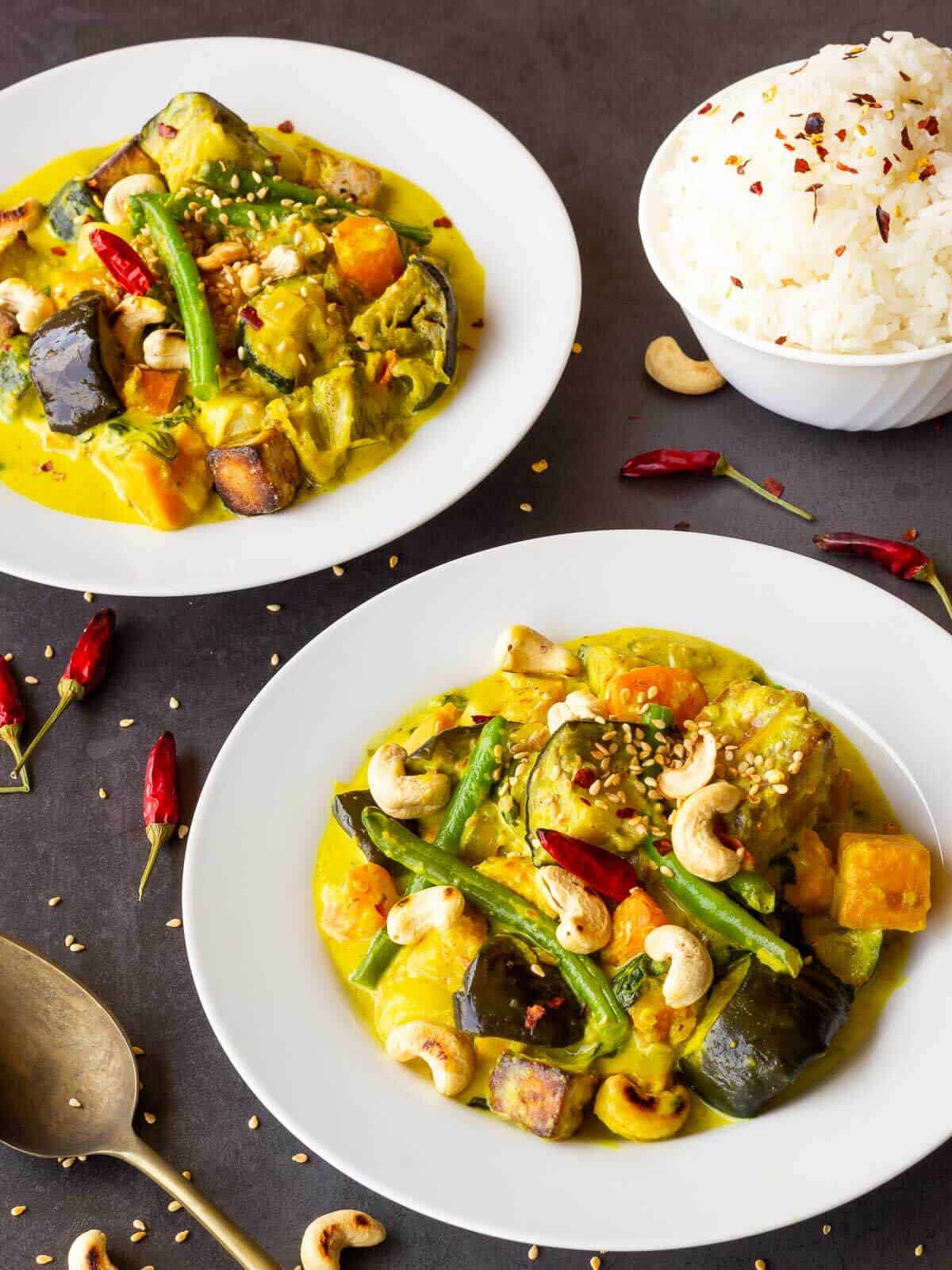
💡Expert tips
Curries are meant to be served with lots of liquid so that you can make nice soaked scoops with Jasmine Rice.
If you feel you don't have much liquid during the last cooking minutes, add some vegetable stock or water to the mix, and let it simmer for a couple of minutes.
Don't overcook the curry. Otherwise, the vegetables will become soggy!
If you want to make a nice appetizer for your curry night, go for something easy, flavorful, and that doesn't require additional plates, like this unshelled, 10-minute garlic edamame recipe.
🥢 How to serve
Every time I serve a curry, garnishing plays a significant role. People get super excited when they see the presentation, which takes a little time—five minutes maximum.
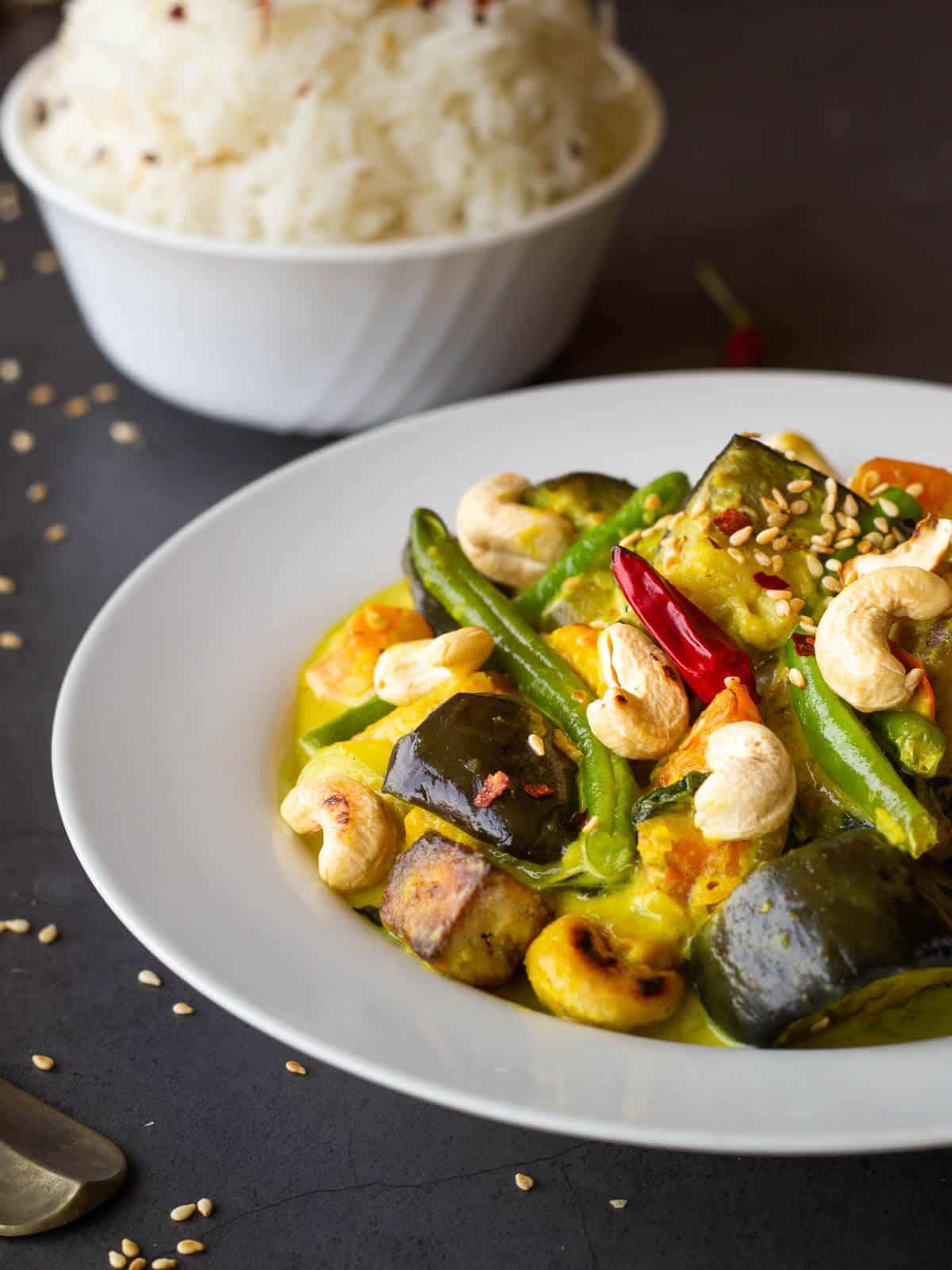
- Extra flavor: add a bunch of kaffir lime leaves, cilantro, Thai basil leaves, or when adding the coconut milk, and save some to garnish.
- Extra protein. Add this crispy tofu. We make Thai yellow curry with extra firm tofu and/or green beans. Thai curries pair very well with tofu.
- Texture. Top with toasted cashews. Toast cashews on low heat for 2-3 minutes in a flat pan right before serving. Soybean sprouts also work beautifully.
- Looks. I use toasted sesame seeds and some coriander leaves. I also like adding chopped green onions' tops. You can also serve the dish with lemon wedges.
- Extra veggies. Use either green beans or bokchoy; add them when the curry is ready and close the lid. The remaining heat will do the work; serve after 5 minutes. Some people like adding red bell pepper; it is certainly not traditional, but it goes well, so feel free to use it.
- Pair. By all means, pair your curry with freshly made aromatic Thai Jasmine Rice. It is one ingredient, and it is made silently while Thai curry is developing its flavor.
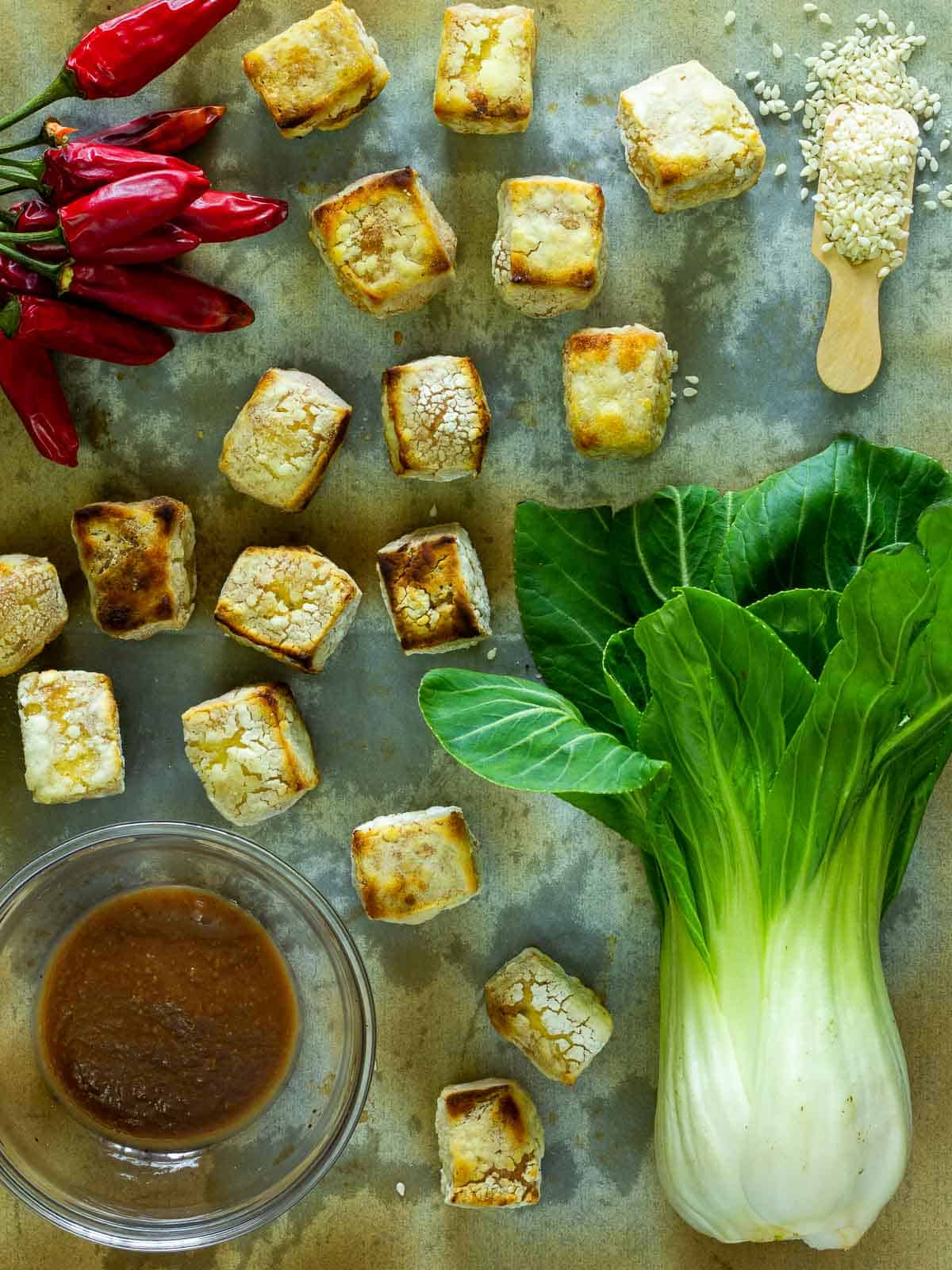
We also love adding some freshly squeezed lime juice to the dish when already served.
📖 Variations
- Spicy - add extra chili while cooking to imbue heat into the dish.
- Flavor - add 2 tablespoons of tamarind and ginger to add some acidity. Also, add extra ginger or lemongrass stalks or paste to add more intensity to the dish flavors. Have fun!
- Soy Sauce: If you're looking to add an umami kick to your curry, a splash of soy sauce can do wonders. It deepens the flavors and gives the dish a savory twist.
- Tamari: For a gluten-free option that doesn't skimp on flavor, tamari is your best bet. It's similar to soy sauce but without the wheat, making it a great alternative for those with gluten sensitivities.
- Yellow Curry paste - feel free to use any curry paste. Before making my own, I used to buy this vegan yellow curry paste from Amazon.

❓ FAQ
Yes, feel free to substitute or add vegetables based on availability or preference.
Absolutely, it stores well and flavors deepen overnight.
🥡 Storage
I always double quantities because curries are always better the next day. The flavors intensify. Not only that, but curries are great for meal prepping.
If you have leftovers the next day, don't bother freezing the yellow curry. You may sneak to the fridge and grab cold spoonfuls packed with glorious flavor.
Freeze and thaw either in the microwave or at low heat before eating. Even better, leave it thawing 5 hours before in the fridge and warm it up gently. It is always better to expose the veggies to less heat to retain more of their texture and Nutritional value.
🥘 More curry recipes
- Thai Green Vegan Curry
- Eggplant Curry
- Fresh Red Thai Curry
- Chickpea Coconut Curry
- Vegetable Massaman Curry
- Pineapple Thai Curry
If you love zucchini dishes, give this Lebanese-style stuffed zucchini a try; you will love them. We also use them to make vegan ceviche and lemony winter risotto; they are perfect because they can absorb tons of flavor.
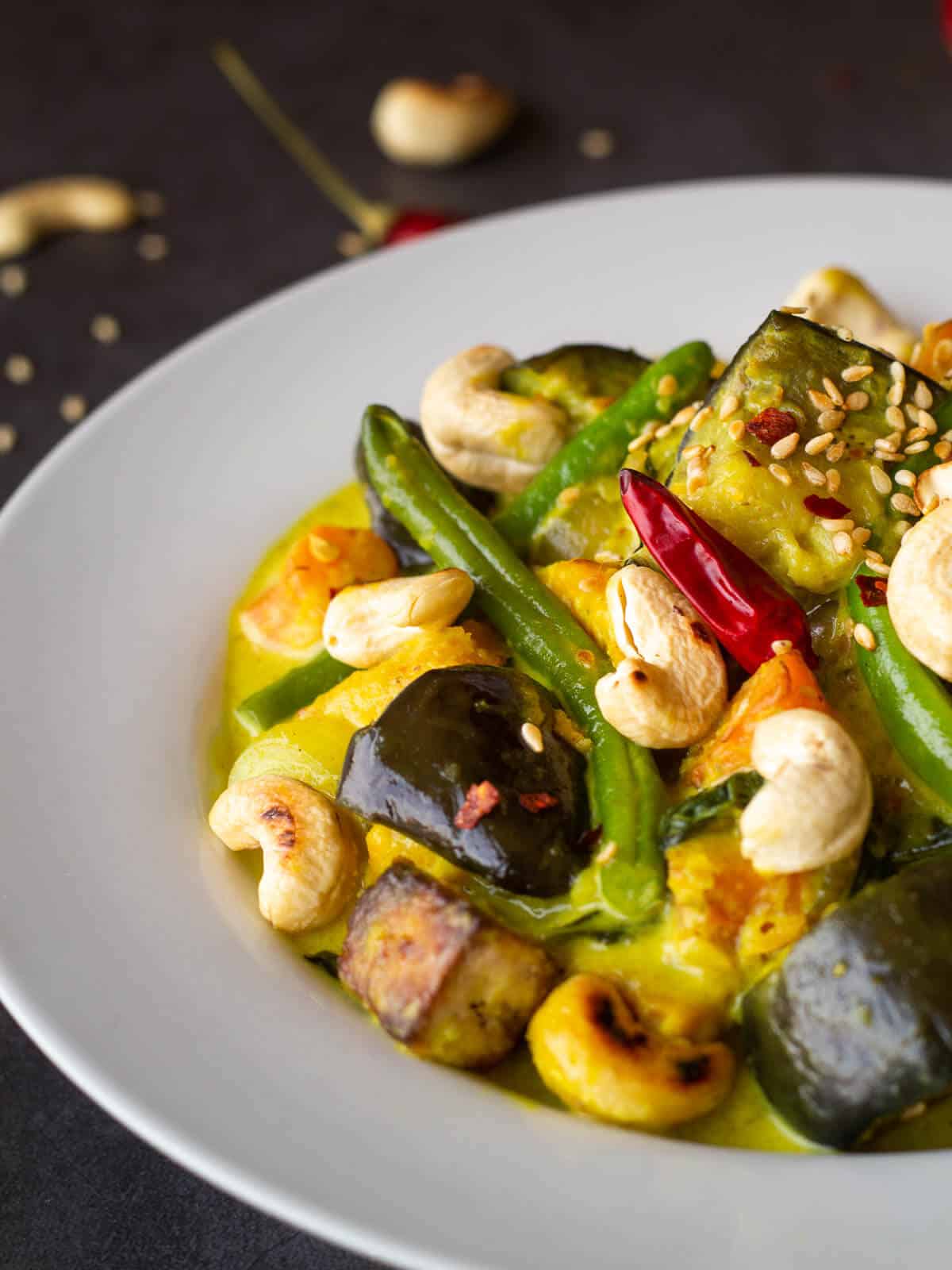
If you try this recipe, let us know! Leave a comment, rate it, and don't forget to tag a photo #ourplantbasedworld on Instagram. Cheers!
🎥 Video
📋 Recipe
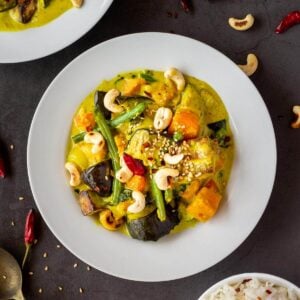
Vegetarian Thai Yellow Curry Recipe
Equipment
Ingredients
- 10 oz sweet potato diced
- 1 eggplant medium, diced
- 3 carrots small
- 1 zucchini
- 3 shallots
- 3 cloves garlic
- 1 tablespoon oil common or coconut oil
- 8 oz coconut milk add more if want it creamier
- 2 tablespoons yellow curry paste
- 2 tablespoons ginger freshly grated
- 3 cups water or vegetable stock
- 8 oz crispy tofu optional, included in nutrition facts
- 1 oz cashews optional, included in nutrition facts
Optional extras:
- 1 cup coriander about a bunch, chop only half
- 10 oz green beans without tops
- 1 tablespoon sesame seeds
- 1 bunch bok choy
- 2 tablespoons tamarind paste
- sea salt to taste, optional, omit if following a WFPB diet
- 1 chilli red or yellow
Serve with
Directions
- Dice veggies. Dice the eggplant, sweet potato, zucchini, and carrots into medium-sized cubes. Roast them in a medium pan in a pre-heated oven at 400ºF (200ºC). Optionally, you may choose to add salt and a teaspoon of coconut or avocado oil, to coat the veggie dice. Bake for 15 minutes.You can skip this step and do everything in one pot, the vegetables will lose some of their color and textures, if you have some extra time, use the oven.
- Chop the alilium veggies. Meanwhile, chop the shallots, garlic. Peel and shred the ginger and chili (optional).
- Stir-fry. Heat the sauce pan, add the coconut oil and add shallots and garlic. Keep at medium heat and add the curry paste and ginger. Also, add the chili if using.
- Stir in the coconut milk when the mixture is golden. Add the oven-baked vegetables and a cup of water (or vegetable stock), and let the curry simmer and a creamy sauce form. Then add the spinach (if using), and then add the remaining stock.Add the remaining stock: 1 or 2 cups, depending on how thick you want your curry to be.
- Turn off the heat. Optionally top with the green beans, bok choy and/or crispy tofu (optional). Let the curry settle for 5 minutes before serving.
- Garnish with toasted cashews and sesame seeds.
Video
Notes
Nutrition Facts
Nutritional Disclaimer
The information shown is an estimate provided by an online nutrition calculator. It should not be considered a substitute for a professional nutritionist's advice. See our full Nutritional Disclosure here.
Affiliate Disclaimer
Please note that some of the links here are affiliate links, and I will earn a commission if you purchase through those links. I recommend all of the products listed because they are companies I have found helpful and trustworthy.
As the lead content writer and recipe developer at Our Plant-Based World, he combines his passion for health and sustainability with a Plant-Based Nutrition Certification to create accessible, delicious vegan recipes. His expertise in plant-based cooking supports the blog's mission of fostering a healthier, environmentally conscious lifestyle through simple and seasonal dishes. His commitment to making vegan cooking enjoyable and inclusive for everyone shines in each recipe and article.

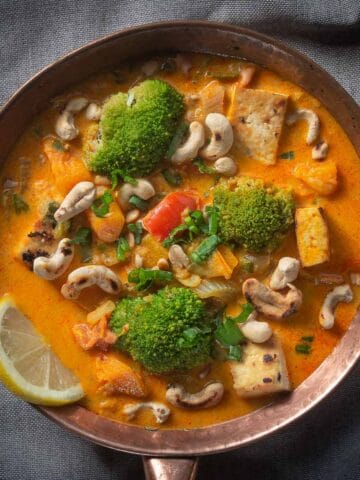
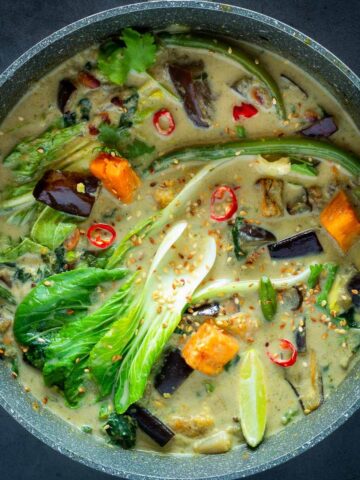
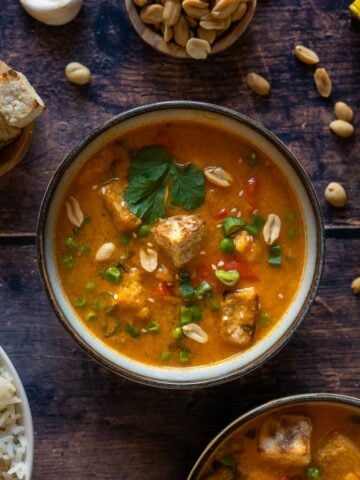
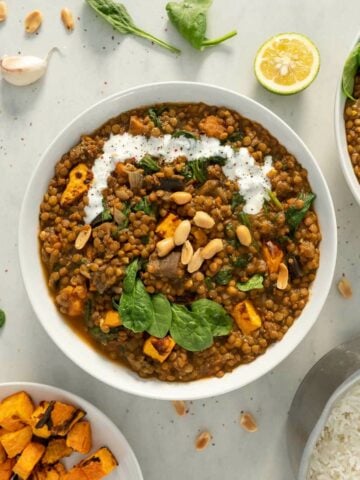






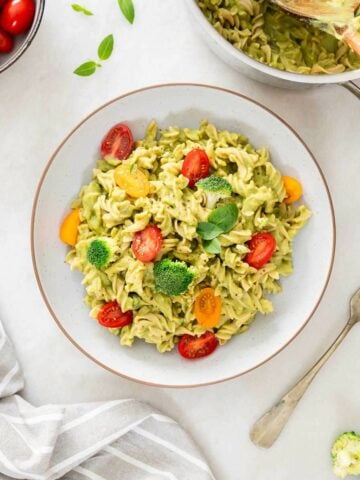
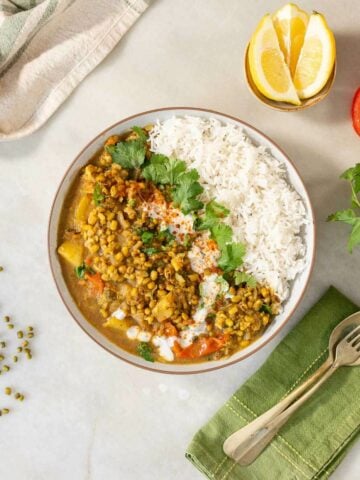
Tiffany
Hi there,
I followed the directions exactly, but after adding the coconut milk with a cup of broth, it never got creamy. I simmered for about 15 minutes. After I realized it wasn't going to get creamy, I went ahead and added another cup of broth, let it sit a for about another 15 minutes, and it stayed watery, more like a soup. Do you know what went wrong?
Our Plant-Based World
Hi Tiffany! Thanks so much for trying the recipe and for reaching out 💚Sorry to hear the curry didn’t turn out as expected. A couple of things could have made a difference here and we are just theorizing...
Coconut Milk Type: Was it full-fat coconut milk or a light version? For the creamiest texture, we recommend full-fat canned coconut milk. Light versions or boxed coconut milk can be much thinner and won’t yield the same richness.
Simmer Time & Heat: Simmering gently (not boiling) and uncovered helps the liquid reduce and concentrate, thickening the curry. If it simmered with the lid on or at a lower temp, it might not have had enough time to reduce.
Yellow Curry Paste: Was it store-bought? Some brands are more concentrated than others, and a mild one might not thicken as much. You could add ½ to 1 tsp of cornstarch mixed with a little cold water near the end next time, or cook uncovered for a bit longer to help reduce it.
Next time, you can also add less broth at the start, then adjust as needed to get your perfect consistency.
Hope that helps! Let us know if you would give it another go — we’d love to hear how it turns out for you.